Fire and Life Safety manages over 2,000 portable fire extinguishers at Santa Clara University. Portable fire extinguishers are intended as a first line of defense to cope with fire of limited sizes. The presence of a fire extinguisher can save you from a catastrophic event.
Services include:
- Fire extinguisher annual inspections
- Fire extinguisher installs and removals
- Fire extinguisher hands on training
- Monthly inspections
- Plan review for new construction and remodeling projects
Types of Fire Extinguishers
- Extinguishing agent: 5-20 pounds of monoammonium phosphate
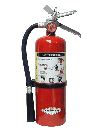
- Use: Class A, B and C fires
- Range: 15 feet
- Found in hallway and occasionally in laboratories
- Extinguishing agent: 5-10 pounds of liquid CO2
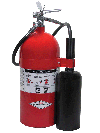
- Use: flammable liquid or electrical fires
- Range: 4 to 6 feet
- Found in laboratories or mechanical rooms
- Can be identified easily because it does not have a pressure gauge
- Extinguishing agent: bromochlorodifluoromethane, halon 1211
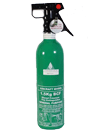
- Use: around computers and sensitive equipment
- Range: 15 feet
- Operates similar to an ABC extinguisher
- Very clean and doesn't leave a residue
- Extinguishing agent: copper or sodium chloride based powder
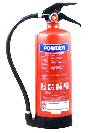
- Use: metal fires
- Range: 3 - 6 feet
- Operates similar to ABC, Halon, and CO2 extinguishers
- Mounted on two-wheeled carts
- Extinguishing agent: wet potassium acetate base

- Use: cooking oil fires
- Range: 10 - 12 feet
- Spray lasts for 40 seconds
- Found in kitchens
How to Use a Fire Extinguisher
When fighting a small fire, maintain an unobstructed exit route at your back and stand six to eight feet away from the fire. Follow PASS to properly use the fire extinguisher.
| P is for PULL - Pull the pin, breaking the tamper seal |
| A is for AIM - Aim the nozzle or hose low at the base of the fire. |
| S is for SQUEEZE - Squeeze the lever above the handle to expel the extinguisher agent. To stop, release the lever |
| S is for SWEEP - Sweep the nozzle or hose side to side at the base of the fire until the fire is put out |
Continue to monitor the area. If the fire reignites repeat Aim —> Squeeze —> Sweep
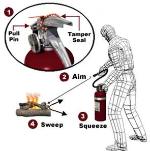
The Five Classes of Fire
There are five classes of fire. Each extinguisher is labeled with standard symbols or letters to indicate which class of fire it can be used on.
Fires consisting of ordinary combustible materials like wood, cloth, rubber, paper, and/or plastics.
Fires consisting of flammable liquid or gas, combustile liquid or gas, petroleum grease, tar, oil, oil-based paint, solvent, lacquer, and/or alcohol.
Fires consisting of energized electrical equipment (ie power tools), wiring, fuse boxes, appliances, TVs, computers, and electrical motors.
Fires consisting of combustible metals like magnesium, sodium, lithium, potassium, titanium, and/or zirconium.
Fires consisting of cooking oils, vegetable or animal fats, commercial cooking equipment.
Training Resources
- Fire Extinguisher Training Guide
- The ABC's of Portable Fire Extinguisher Selection, Use and Maintenance
- Portable Fire Extinguishers - Understanding Their Use and Limitations